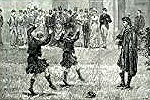This volume, as well as recording details of Scottish weapons and Highland wear etc., had two pages on historic bagpipes. At the time, in the 1960s, I was able to get the library to photocopy for me the two pages which I am now sending to you. Page one is of a set of pipes as played by one John McKenzie in 1874 when winning a solo piping contest.
The whole page is drawn up by an architect and shows sections through the pipes as well as a practice chanter with detailed information such as ‘showing number of holes to be covered for each note’. Also depicted are the positions on the pipe bag for the drones as well as details of the reeds, drone and chanter. The text reads: ‘Modern Highland Bagpipe. First Prize for Pibroch Playing: won by Mr John MacKenzie: piper to the ?? at the Northern Meeting, 17th September 1874.’
The second page, also drawn by, presumably, the same architect, shows two old sets of circa 1770 pipes, the first with a single drone (which remind me of Galician bagpipes), ‘The McIntyre Pipes’ belonging to a Robertson MacDonald, Kinlochmoidart. The second set is a two drone pipe, again with lots of details. The page also states that this two drone set ‘belonging to Messrs. Glens of Edinburgh. The chanters are described as ‘Feadan Dubh Chlann Chatain’ – Black Chanter of Clan Chattan – and ‘Feadan from Drummond Collection’.
The Editor comments: ‘That is fascinating information and many thanks Allan. Our records show that a John MacKenzie did indeed win the Prize Pipe at the Northern Meeting in 1874 where he is noted as attached to the Royal Caledonian Asylum, London, (not to be confused with an institution for those with mental illness). I wonder how these pipes (first pic) differ in dimension from sets played and made today. I suspect not a lot. Both drawing are remarkable in their detail and it would have taken a skilled draughtsmen/ architect to fit all of the information clearly onto one page – and to scale! His attention to detail and determination that they be considered a true reflection of these instruments and not an artist’s impression even extends to his going as far as to confess, ‘the unshaded parts are reconstructions’.’
[wds id=”2″]
If any reader wishes to study these diagrams in greater detail then we will be happy to supply a high resolution PDF of same. Of the Royal Caledonian Asylum, Wikipedia notes: The Caledonian Asylum was launched by members of the Highland Society of London in 1815 to provide a home and education for Scottish children in London who had been orphaned in the Napoleonic Wars.

‘John Galt, the novelist, became secretary to the Asylum in 1815. The first Asylum was at 16 Cross Street, Hatton Garden, London, from December 1819 until 1828 when it relocated to Copenhagen Fields, Islington. Its long residence in Islington resulted in the naming of Caledonian Market and the Caledonian Road. In 1852 Queen Victoria became Patron and the Asylum was renamed the Royal Caledonian Schools, although legally it was and still is the ‘Caledonian Asylum’. At that time it catered for about 70 boys and 50 girls. The Asylum’s band occasionally played at charitable and other events.’
[wds id=”2″]